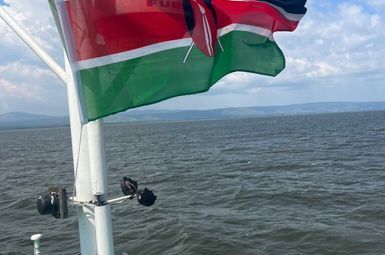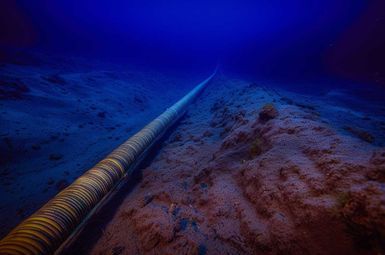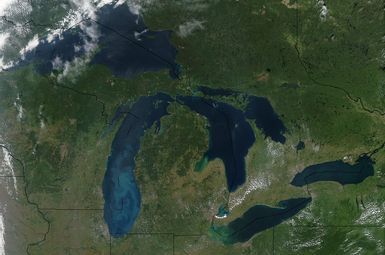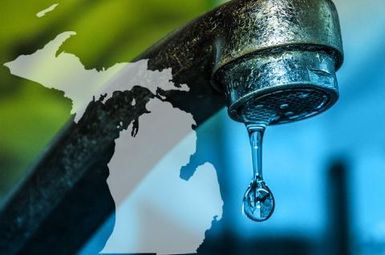
Humanity can farm more food from the seas to help feed the planet while shrinking mariculture’s negative impacts on biodiversity, according to new research led by the University of Michigan.

Water is central to Michigan’s identity and economy, but monitoring its continued health and safety is not enough. That’s why the University of Michigan is partnering with communities across the state and beyond to address critical infrastructure issues that affect the health and safety of water resources. U-M researchers, for example, are developing autonomous technologies for aging stormwater systems to reduce the impacts of flooding — potentially saving lives and preventing billions of dollars in property damage. This type of collaborative approach to solving critical infrastructure issues will better integrate our built and natural environments, helping protect one of the state’s most valuable resources.

Humanity can farm more food from the seas to help feed the planet while shrinking mariculture’s negative impacts on biodiversity, according to new research led by the University of Michigan.

To try to understand how harmful algal blooms might evolve in Lake Erie in a warming climate, University of Michigan scientists helped conduct a survey of cyanobacteria in a gulf of Kenya’s Lake Victoria.

Water desalination plants could replace expensive chemicals with new carbon cloth electrodes that remove boron from seawater, an important step of turning seawater into safe drinking water.

Research led by the University of Michigan shows that communities of color in Texas face pronounced risks of E. coli exposure in nearby waters after intense rain.

In certain parts of the U.S., the ability of residents to prepare for and respond to flooding is being undercut on three different levels.

The University of Michigan Center for Sustainable Systems (CSS) and U-M's Naval Architecture and Marine Engineering have been awarded a $199,993 grant from the State of Michigan to develop a Michigan maritime strategy focused on climate action.

U-M has received a $25 million grant from the National Oceanic and Atmospheric Administration to support collaborative research initiatives addressing critical environmental challenges in U.S. coastal communities.

Anyone who’s spent their winter months around the Great Lakes has probably had the uncanny experience of living through three seasons in a single weekend. According to new research from U-M, these wild weather swings are poised to become even more common in the future.

Nestled by the St. Clair River, a small rural neighborhood in St. Clair Township, Michigan, is surrounded by a high concentration of hazardous crude oil and natural gas facilities. For decades, Murphy Drive residents have been exposed to unreported chemical releases, oil spills, poor air quality and harmful odors.

Great Lakes researchers at U-M have been awarded a $6.5 million, five-year federal grant to host a center for the study of links between climate change, harmful algal blooms and human health. Increased precipitation, more powerful storms and warming Great Lakes waters all encourage the proliferation of harmful algal blooms composed of cyanobacteria.

Three new U-M sustainability catalyst grants will support novel research projects to address vexing environmental challenges. “Catching the Waves” focuses on deploying wave energy converters to power remote coastal communities, starting with Beaver Island in Lake Michigan. “Mussel Roads” uses biomimicry to enhance asphalt durability by developing materials inspired by mussel-binding proteins. “Plast-ick,” leverages artificial intelligence and satellite data to predict pollutants like PFAS in water bodies.

Michigan is home to 43 species of native freshwater mussels, 30 of which are considered to be at risk of extinction. Among the many factors that threaten the hard-shelled bottom dwellers are competition from invasive zebra and quagga mussels, water pollution, and—especially—dams.

The new projects include “Plast-ick,” which leverages AI and satellite data to predict pollutants like PFAS in water bodies; “Catching the Waves,” which focuses on deploying wave energy converters to power remote coastal communities; and "Mussel Roads," which uses biomimicry to enhance asphalt durability by developing materials inspired by mussel-binding proteins.

In a new effort to support decarbonizing the maritime shipping industry, U-M has entered into a strategic partnership with the Copenhagen-based Mærsk Mc-Kinney Møller Center for Zero Carbon Shipping.

Researchers at U-M’s Rogel Cancer Center want to build a movement to understand how exposures to toxic metals, industrial pollution and “forever chemicals” called PFAS, are impacting the health and cancer risk of residents across Michigan.

U-M is marking late March and all of April with a series of events focused on sustainability and climate action, continuing a tradition that began with the first “Teach-In on the Environment” in 1970—which grew into what is now known as Earth Day.

The global challenges posed by climate change are widespread, impacting various aspects of human life, with water resources at the forefront of these challenges. As climate change advances, it is projected to exacerbate water scarcity and access issues, given the intensification of water-related hazards (such as hurricanes and flooding) and rising temperatures that will lead to sea-level rise and saltwater intrusion.

Six new research projects will investigate the shifting dynamics of harmful algal blooms, economic trends in coastal communities, emerging fish viruses, and other issues relevant to the Great Lakes.

Fiber optic cables that line ocean floors could provide a less expensive, more comprehensive alternative to the current buoys that act as early warning systems for tsunamis, says a U-M researcher.

U-M is a partner in the Great Lakes Water Innovation Engine, one of ten regional hubs the National Science Foundation announced this week as part of a program that’s among the largest broad investments in place-based research and development in the nation’s history, according to NSF.

The need for a compact came when, twenty-five years ago, a Canadian company decided they could fill tanker ships with Great Lakes water to sell to countries with water shortages. Wanting to protect the lakes, the Great Lakes states, along with Ontario and Quebec, began the complex negotiations that would lead to the formal agreement detailing how they’d work together to manage as well as protect the Great Lakes.

The Environmental Health Research-to-Action Academy is a community-academic partnership focused on building skills and intergenerational knowledge in environmental health, community science and policy advocacy to address cumulative environmental exposures in the nearby communities.

While Legionella bacteria can be found in natural freshwater environments, outbreaks of Legionnaires’ disease are more often associated with large water systems in public buildings, cooling towers, and other places where water is stagnant or flows at a low rate.

Flint residents have learned to question everything in the decade since the city’s drinking water first began showing signs of lead contamination. Even now, after seven straight years with water meeting federal safety guidelines, the lack of trust remains for many. U-M researchers and their partners are addressing this lingering problem on multiple fronts — from continued testing to in-school education and consulting with the city.

Over the course of the semester, U-M students are investigating drinking water-related issues in Michigan — including contamination, accessibility and affordability — to propose novel solutions.

LSA’s Detroit River Story Lab teaches students from elementary school through college about the past and future of the vibrant body of water.

Each peer-reviewed factsheet presents data on patterns of use, life cycle impacts, and sustainable solutions. Updated annually by a current SEAS graduate student, the collection is a free resource to inform journalists, policymakers, business professionals, students, teachers and the public.

Nearly $1.23 billion has been spent by the U.S. government since 2004 on the cleanup of toxic pollutants in waterways resulting from manufacturing activities in historic areas around the Great Lakes.

“Water management will be one of the challenges of our generation,” Gilchrist told students. “In order to understand how we can meet that challenge, we need smart, we need bold, we need connected information professionals to be part of the process.”

U-M researchers will lead a new effort to strengthen the climate change resilience of vulnerable communities that span international boundaries and jurisdictions. The U.S. National Science Foundation has awarded $5 million to U-M to establish the Global Center for Understanding Climate Change Impacts on Transboundary Waters.

PFAS have contaminated water, food, and people through products such as Teflon pans, waterproof clothing, stain-resistant carpets and fabrics, and food packaging. They are often referred to as “forever chemicals” because they are resistant to breaking down and therefore last for decades in the environment.

“Water conservation and access” brings a slew of images to mind: wastewater flowing through main lines to a city treatment plant, a fisherman yanking invasive mussels off the hull of a trawler, the installation of filters in communities that lack access to safely managed drinking water.

The devastating floods that ripped through the northeast United States are among the most recent in a long string of severe flooding events occurring worldwide, which make it plain that better flood predictions and safety plans are needed. According to the Organization for Economic Cooperation and Development, flooding causes $8 billion in losses on average annually in the U.S. alone.

Should states and Indigenous nations be able to influence energy projects they view as harmful or contrary to their laws and values? This question lies at the center of a heated debate over Enbridge Energy’s Line 5 pipeline, which carries oil and natural gas across Wisconsin and Michigan.

The tools and policies that worked to significantly reduce threats to the Great Lakes over the past century are ill-equipped to handle today’s complex and interrelated challenges. A new set of stewardship principles is needed to work holistically and systematically on long-term social, economic, environmental, and racial-equity and resiliency concerns that have too often been sidelined in a rush for immediate results.

Lake Erie harmful algal blooms consisting of cyanobacteria, or blue-green algae, are capable of producing microcystin, a known liver toxin that poses a risk to human and wildlife health. Such blooms may force cities and local governments to treat drinking water and to close beaches, and they can harm vital local economies by preventing people from fishing, swimming, boating and visiting the shoreline.

Michigan is blessed with a significant portion of the world’s freshwater supply, but water quality and affordability have been persistent issues affecting households throughout the state. Because of the suburbanization of poverty, there are now more residents struggling to afford and access clean, safe water in suburban communities where there are also fewer social welfare institutions to meet their needs.

Scientific studies have shown that exposure to some PFAS in the environment may be linked to harmful health effects in humans and animals. Because there are thousands of PFAS chemicals found in many different consumer, commercial, and industrial products, it is challenging to study and assess the human health and environmental risks.

Now more than 100 years old, the Biological Station is a 10,000-acre property in the northern Lower Peninsula of Michigan whose core mission is to advance environmental field research, engage students in scientific discovery, and provide information needed to understand and sustain ecosystems from local to global scales.

Participating in our democracy, particularly locally, and organizing for systems and policy change to promote the collective good is critical to building a clean energy future that is just and works for all. This was the overall sentiment of a panel that brought together three community activists and organizers who have emerged as powerful leaders that work on pushing forward solutions that consider the rights of all people.

By directly measuring greenhouse gas emissions from an airplane flying over the Gulf of Mexico, a U-M team found that the nation’s largest offshore fossil fuel production basin has twice the climate warming impact as official estimates.

“By having access to this information, people can make informed decisions about their behavior if they have a personal concern about the levels of pathogens detected in their community.”

As climate change and population growth make water scarcity increasingly common, a much larger share of the global population will be forced to reckon with the costs of urban water scarcity. A new study sheds light on how households bear the monetary and nonmonetary costs when water supply is intermittent, rather than continuous—with policy implications that could help make urban water safer, more sustainable and more equitable.

State agencies and the U-M Water Center will work to understand and reduce Michigan’s nutrient runoff to Lake Erie, as well as design and implement a diverse, robust and transparent advisory process to inform the state’s adaptive management plan for the lake.

“I wish to use this fellowship to answer these questions in the context of Mexico, documenting through “day in the life”-style illustrations of various people and communities interacting with water. I hope my findings can be transferable to other countries and regions facing similar challenges.”